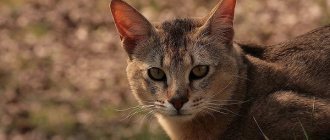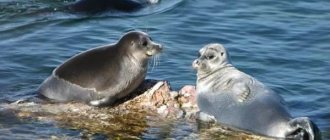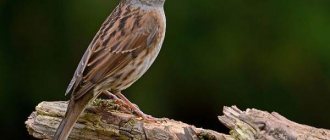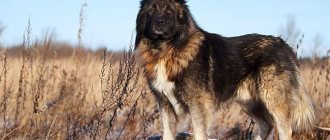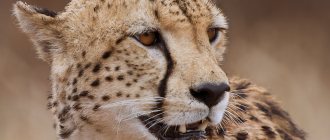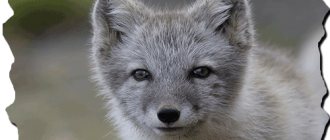This is the largest desert on Earth. It is located in North Africa, where it covers an area of about 8.6 million km2, which is 30% of the area of the entire continent. The Sahara covers the territory of more than a dozen states. Vast areas of this desert are not inhabited by people, and the sedentary lifestyle is limited to oasis areas. Average daily temperatures in summer here exceed +40°C, and the surface of the earth can warm up to +70-80°C.
Desert fauna: Dromedary camel
© Anna_Pakutina / Getty Images
It is worth noting that in the past, a large number of dromedary camels (or dromedaries) roamed the deserts of North Africa, but today only domesticated animals can be found, which, being incredibly strong and hardy animals, help people in African and Asian countries to transport heavy loads.
They are also used for riding. Contrary to the opinion of many people, these animals do not store water in their hump, but fat, which they feed on in case of food shortage.
Relief
In fact, sand occupies only a quarter of the Sahara, and the rest of the territory is occupied by stone structures and mountains of volcanic origin. In general, we can distinguish the following objects in the desert:
- Western Sahara - plains, mountains and lowlands;
- Ahaggar - highland;
- Tibesti - plateau;
- Tenere – sandy expanses;
- Libyan Desert;
- Air - plateau;
- Talaq – desert;
- Ennedi – plateau;
- Algerian desert;
- Adrar-Iforas - plateau;
- Arabian Desert;
- El Hamra;
- Nubian Desert.
The largest accumulations of sand are in such sandy seas as Igidi and the Great Eastern Erg, Tenenre and Idehan-Marzuk, Shesh and Aubari, the Great Western Erg and Erg Chebbi. There are also dunes and dunes of various shapes. In some places there is the phenomenon of moving and also singing sands.
Desert terrain
If we talk in more detail about the relief, sands and the origin of the desert, scientists claim that the Sahara was previously an ocean floor. There is even a White Desert here, in which white rocks are the remains of various microorganisms of antiquity, and during excavations paleontologists find skeletons of various animals that lived millions of years ago. Now sands cover some parts of the desert, and their depth in some places reaches 200 meters. Sand is constantly transported by winds, forming new landforms. Under the dunes and sand dunes there are deposits of various rocks and minerals. When people discovered oil and natural gas deposits, they began to extract them here, although it is more difficult than in other places on the planet.
Animals living in the desert: Dorcas gazelle
© Fotomicar/Getty Images
This animal has a sandy color, which helps it camouflage in the desert. Thanks to the dew on the plants it feeds on, as well as the consumption of water-conserving plants, this gazelle can almost never drink.
The animal can reach a height of 65 cm and a weight of 25 kg. It is worth noting that the Dorcas gazelle instinctively jumps away when a predator approaches. This reflex serves as a warning signal to other gazelles. In addition, the Dorcas gazelle runs very quickly, reaching speeds of almost 80 km/h.
Horned viper
This poisonous snake, 60-80 cm long, inhabits the entire Sahara Desert, adjacent foothills and dry savannas. Its characteristic feature is 2 spiny scales above the eyes. During the day, the horned viper burrows into the sand or hides in rodent holes, and at nightfall it goes out to hunt for small rodents, lizards and birds. It is capable of completely burying itself in the sand in 10-20 seconds, leaving no traces on the surface.
What animals live in the desert: Addax (or mendes antelope)
© wrangel/Getty Images
Previously, addaxa could be seen in deserts and semi-deserts stretching from Western Sahara and Mauritania to Egypt and Sudan. Today, the range has decreased significantly - the Mendes antelope can be found only in a few sandy and rocky deserts of Niger, Chad, Mali, Mauritania, Libya and Sudan.
Thanks to the structure of their paws, these creatures can move through difficult, sandy areas without problems. But the same thing makes them vulnerable to danger - it is difficult for them to escape from predators. There are about 500 individuals in the world.
Scorpios
This is the oldest order among terrestrial arthropods. They are found only in hot countries. In the desert, scorpions hide among the stones. There they hide from the burning rays of the sun, waiting for darkness and coolness to come. As soon as dusk sets in, the scorpion, like a spider, quickly runs with its tail raised up, carefully feeling the road and all objects with its legs. Scorpions feed on insects and arachnids. They capture prey with their claws, lift it up above the cephalothorax and kill it with an injection of a poisonous sting, which is located at the end of the hind belly.
Scorpion poison
Scorpion sting
There are 2 types of scorpion venom. The first can kill or paralyze an invertebrate, but for humans it is no more dangerous than a wasp sting. The second can be fatal for people - it paralyzes the brain, nerves of the heart and pectoral muscles. In total, about 25 species of scorpions are known to be dangerous to humans. Their poison can cause uncoordination of movements, salivation, and vomiting. The affected area swells, turns red, itches, and hurts. There is a simple way to determine how poisonous a given scorpion is. If the claws look small compared to the huge stinger on the tail, then there is a lot of poison in this scorpion and it is better to stay away from it.
Mirages
In the Sahara, unique optical phenomena are observed in the atmosphere, thanks to which a person is able to see objects, for example, water sources, which in reality are very far away, tens or even hundreds of kilometers away. These phenomena are called mirages. They are explained by the total reflection of rays at the boundary of two layers of air having different temperatures and densities. There are even special maps of caravan routes in the Sahara with an assessment of the places where mirages usually occur.
Share link
What animals live in the Sahara Desert: African ostrich
© vblinov/Getty Images
Although the ostrich cannot fly, it is one of the fastest animals on Earth, capable of reaching speeds of up to 70 km/h.
But besides its speed, the ostrich can boast of several more characteristics: it can move great distances, has excellent hearing and vision, and can safely fight off predators with its powerful legs.
Mainly feeds on grass, but sometimes eats small animals. Ostriches from the Sahara Desert are a separate subspecies.
Antelope oryx
This is a species of saber-horned antelope native to Africa. This animal is also called the oryx. The height of the oryx at the withers is about 120 cm, body weight is 200 kg. Both males and females have very long, thin, almost even horns, ranging from 100 to 150 cm in length. A characteristic feature of this antelope is the black and white coloring of the head. Oryx are very resilient and are able to run at high speed for tens of kilometers. In addition, they are quite brave animals and often go on the offensive when attacked by predators. A large male oryx can even kill a lion with its sharp horns.
Animals of deserts and semi-deserts: Jerboa
© Yerbolat Shadrakhov/Getty Images
This rodent lives in steppes, semi-deserts and deserts of the Palaearctic. It is able to withstand harsh climatic conditions.
In addition, this nocturnal animal is distinguished by its jumping ability - a quality that allows it to avoid predators.
Despite the fact that its body size can reach a length of only 25 cm, it is capable of reaching speeds of up to 25 km/h. Another interesting fact is that the jerboa does not drink water in the literal sense of the word; it obtains moisture from the food it eats. This rodent usually feeds on plants growing in the desert, seeds and insects.
Holy Scarab
A species of beetle from the lamellar family. The sacred scarab is considered the most powerful insect on Earth. These large black beetles reach 3-4 cm in length and weigh about 2 g. Scarabs are famous for their ability to move loads that are several times the weight of their own body. In ancient Egypt, the scarab was worshiped as a deity. The Egyptians saw his rolling of large dung balls as a symbol of the movement of the sun across the sky.
Water resources of the Sahara
The main source of the Sahara Desert is the Nile and Niger rivers, as well as Lake Chad. Rivers originated outside the desert and are fed by surface and groundwater. The main tributaries of the Nile are the White and Blue Nile, which merge in the southeastern part of the desert. The Niger flows in the southwest of the Sahara, in the delta of which there are several lakes. In the north there are wadis and streams that form after heavy rainfall and also flow from the mountain ranges. Inside the desert itself there is a network of wadis that was formed in ancient times. It is worth noting that under the sands of the Sahara there is underground water that feeds some reservoirs. They are used for irrigation systems.
River Nile
Sandy efa
Found north of the African equator, sand ephs (Echis carinatus) are small but vicious snakes. On average, adult vipers reach a length of less than a meter. They make a “hissing” warning sound when their scales rub against each other. Snake venom is hemotoxic and very dangerous.
According to some researchers, the sand ephemeral venom is 5 times more toxic than the venom of the cobra and 16 times more toxic than the venom of the Russell's viper (one of the deadliest snakes in Asia).
fennec
Fennec foxes are mammals from the Canidae family that look like miniature foxes. They inhabit deserts, the largest population lives in the Sahara. These foxes are even smaller than adult domestic cats: their body length is 30-40 cm, their tail is up to 30 cm. The fennec weighs no more than 1.5 kg. Predators, nocturnal.
Interesting features of fennecs:
- The fennec cat has the largest ears in relation to the size of its head among predators. The length of the ears is up to 15 cm. Such ears help to regulate body temperature in the heat and to navigate well when hunting: to hear the slightest rustle of small vertebrates and insects.
- The feet are covered with thick down. Such “socks” help the fennec cat move along the hot desert sand.
- Young fennecs are almost white, and with age they become reddish or fawn, adapting to their habitat.
- Fenechs dig holes with a lot of secret passages.
- Fenechs are very social: they live in groups of several families and communicate with each other (bark, grumble, whine and howl).
- Fenechs are omnivores: they dig up eggs and underground parts of plants, eat fruits, carrion, insects and small vertebrates.
- Fenech jumps from a place to a height of 70 cm.
- Fenech is a symbol of Tunisia's ecology. In almost every city there are figures of this animal in a blue and white suit.
- The Firefox mobile browser logo features a fennec.
Death in the Sand: Giant Snakes from Saharan Legends
Spanish writer Miguel Segui, who worked for the magazine Año Cero, once spoke with a local camel rider named Mohamed Charaa during a trip to Tunisia.
The conversation was about how dangerous it is to travel through the Sahara Desert, namely in its northern part. Charaa began to detail the dangers he faced, and then mentioned a strange bike that was circulating in the area of the city of Gafsa.
This place, also known as the Oasis of Capsa, according to the locals is home to huge snakes, which they call " taguerga" and which are also known as "Saharan Crested Snakes".
Outwardly, these snakes are similar to the famous Basilisk; they have on their heads something like a crest or crest, similar to a cock’s, and dark red or black in color.
These snakes can reach 4 meters in length, but some stories describe even monstrous snakes reaching 20-30 meters in length.
These snakes are dangerous not only for their size (like any large boa constrictors, like an anaconda), they are also unexpectedly poisonous and their poison is allegedly deadly for both large animals and humans (Paranormal News - paranormal-news.ru).
Charaa was neither the first nor the last desert nomad to speak of such creatures. In the 1950s, scores of other Tunisian travelers who ventured across the desert reported stories of long, thick snakes that killed goats and sheep.
They have a dark brown coloration on the back, with light speckles, and a whitish belly. The muzzle is pointed, the ridge on the head is about 10 cm high. The neck is narrow, but towards the middle the body becomes very wide, and then tapers again towards the tail.
There is a story about how back in 255 BC during the First Punic War, immediately after a long battle using catapults and siege engines, the legionnaires of the Roman consul Marius Atilius Regulus killed a huge snake 36 meters long. This happened somewhere near the Mejerda River in Tunisia.
The story ends with the description that the skin and jaws of this snake were taken to Rome, and in 133 BC they were exhibited in a certain temple for public viewing.
Let's return to Miguel Segui. He became interested in the story of the giant Sahara snakes and soon learned another story. It occurred in Algeria in the late 1950s. One day, a detachment of the French army was urgently called to the area of the Algerian city of Beni-Unifa, because desert nomads stumbled upon a huge snake and could not kill it.
When the French soldiers saw this snake, they were horrified; the snake was 20 meters long. The nomads were unable to kill the snake with their guns, so the French had to resort to using a heavy machine gun.
The snake was skinned and kept in one of the premises of the French army. But when the soldiers had to quickly leave the country after the unrest began, in the turmoil the skin of the snake was irretrievably lost.
Next, Segi told a story that happened literally a year before his arrival in Tunisia. A young girl from a nomadic village was attacked by a snake that reached about 5 meters in length.
They managed to kill the snake and skinned it, so that they could later show it to everyone as a curiosity. Alas, by the time Sega arrived, the skin had already been sold to an unnamed collector for 45 thousand francs.
One of the notable features of Saharan snakes, in addition to their size and venomousness, is the ability to jump very high. From the ground, such a snake can easily jump to the head of a camel or a person sitting on it. Immediately after the jump, she bites her victim hard.
In 1967, while constructing a massive dam in southern Morocco, bulldozer driver Hamza Razmani suddenly saw a huge snake while working, which was much longer than all the local snakes he knew. This snake deftly and quickly crawled towards the barrel of engine lubricant, as if it were some kind of delicacy for it.
Using the bucket of his excavator, Hamza managed to kill the snake and when it was examined, it turned out that the snake was a little over 9 meters long and had what looked like a “mane of hair” on its head.
In subsequent years, unusually large snakes with a crest or horns on their heads were spotted several more times at this dam. One of them was about 10 meters long, the other reached 12-15 meters in length.
Many consider these stories just a tale for the gullible, but we can remind them that in the Pleistocene there lived snakes on Earth that reached a length of 15 meters (Titanoboa). True, they did not live in Africa, but in South America, but they existed thanks to the very warm temperature, so they would also have liked the modern African heat.
Titanoboa eating a crocodile (museum model)
Cape cobra
The Cape Cobra (Naja nivea) has a highly neurotoxic venom that is considered the most powerful of all African cobras. A beautiful snake that varies in both color (from yellow to copper/mahogany and purple/black) and size (average 1.2 meters; can grow up to 1.8 meters).
Human mortality from its bites is +/- 60% if not treated immediately. Death usually occurs between 2 and 5 hours after a human bite and is usually the result of respiratory failure due to the onset of paralysis.
Mozambican cobra
The Mozambican spitting cobra (Naja mossambica) is perhaps the most common cobra in tropical and subtropical Africa. It is considered one of the most dangerous African snakes, second only to the Mamba. As the name suggests, the snake can spit (“spray”, perhaps even more accurately) its cytotoxic venom with great accuracy and reach (jet up to 3 m). Its bite can cause severe tissue damage, while venom in the eye can cause blurred vision or even blindness.
If necessary, it can also rise up to two-thirds of its body length. Can feign death to avoid danger.
